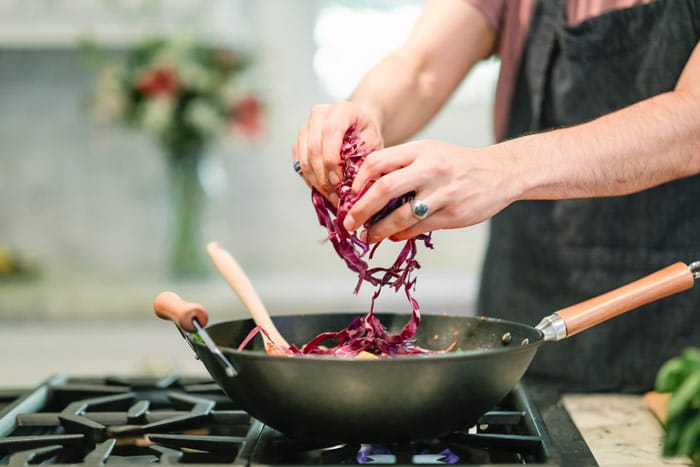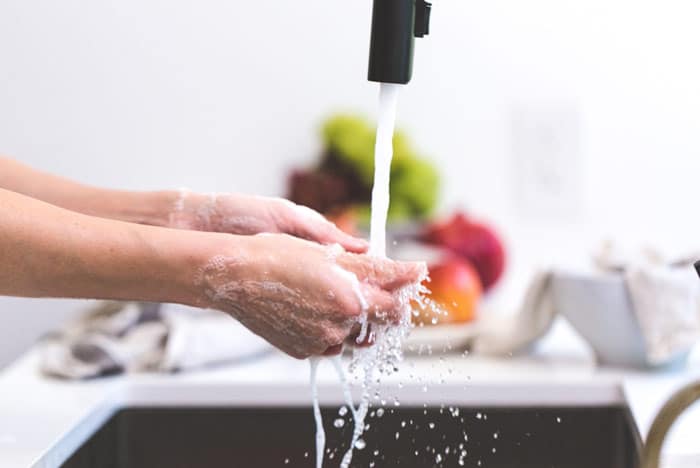Foodborne illnesses are a real health concern for seniors, especially for those who live alone.
Older adults are at a higher risk of getting food poisoning, so a consistent application of food safety rules is particularly important (source).
Unfortunately, many of the cases require hospitalization and some of them may even have a fatal outcome. That’s why food safety for seniors is of great importance and should always be taken seriously.
Consuming food contaminated with bacteria, toxins, viruses, or parasites can lead to gastroenteritis and other foodborne illnesses which are pretty common among elderly people.
This has several reasons:
- Sometimes seniors forget to check expiration dates or store perishable foods way too long before they consume them.
- On the other hand, older adults tend to have a weakened immune system, especially if they suffer from chronic diseases. This condition makes them more susceptible to foodborne illnesses and promotes bacterial overgrowth in the gastrointestinal tract.
As always, the best solution is prevention: by taking precautions you can definitely improve food safety for your elderly loved ones.
So, what are the most important food safety measures seniors should take to prevent foodborne illnesses?
Food safety for seniors in a nutshell:
Rule #1 is that if there are no harmful pathogens in your food you won’t get sick. So you have to avoid and eliminate them at each and every step of food preparation.
Also, you have to prevent pathogen growth in your stored and ready-to-eat foods. You can accomplish this through proper cooking and storage temperatures, safe food handling, and clean hands. Remember your loved ones: when in doubt, throw it out.
Let’s see the details.
1. The Correct Temperature for Cooking
Bacteria usually grow fast and easily between 40°F and 140°F. This is also called the Danger Zone. Always cook food to at least 160°F or even 180°F when you prepare whole poultry. Each type of pathogen has an individual sensitivity to high temperatures, so cooking time also matters.
Don’t be fooled by the look and color: often the food that looks well cooked doesn’t have a high enough temperature inside to kill all the harmful bacteria. When in doubt, a food thermometer can help you to check the exact temperature of the food.
If you apply the appropriate temperature, bacteria in your food won’t have a chance to survive.

2. Reheat Cooked Food Thoroughly to 165°F or Higher
It’s an often-overlooked food safety rule. Leftovers are a good medium for bacteria to grow.
Elderly people are more sensitive to hot dishes, that’s why they tend not to reheat their food thoroughly. However, food that is just lukewarm right after reheating is not safe to consume.
It’s a good practice to cover leftovers in the microwave or on the stove. This way the moisture that is created helps eliminate even more bacteria. As always, you can use a food thermometer to check the temperature.
Soups, gravies, and sauces should be heated until reaching a rolling boil.
The best way to reheat a frozen leftover is to let it thaw in the fridge, however, heating without thawing is also considered to be safe. Never thaw food at room temperature.
3. Never Leave Cooked Food at Room Temperature for More Than 2 Hours
Prepared food should be placed in a fridge set at 40°F or below as soon as possible. Large amounts of food can be divided into smaller pieces to accelerate the cooling process.
Cooked food left at room temperature for more than 2 hours is not safe to consume for anyone, and it’s especially hazardous for elderly people. If the room temperature is above 90°F, refrigerate foods within 1 hour (source).
4. Set the Refrigerator at 40°F or Below to Prevent Rapid Bacterial Growth
Check regularly the temperature in the refrigerator to detect a malfunction in time. It’s especially important to do so on hot summer days. A simple thermometer will do the job.
Temperature as low as 40°F significantly slows down or even stops bacterial growth and improves food safety (source).
The freezer temperature should be 0°F or below.
5. Do Not Store Leftovers in the Refrigerator for More Than 4 Days
Leftovers stored in the fridge for more than 4 days are not safe to consume. However, if you don’t want to throw them away, you can still freeze them.
6. Dirty Hands and Surfaces Can Lead to Infections
Encourage seniors to wash their hands thoroughly with soap for at least 20 seconds before and after food preparation and before each meal. Some gastrointestinal infections are directly related to contaminations transmitted by dirty hands.
It’s also important to clean and wash all the kitchen surfaces, utensils, and cutting boards with hot soapy water regularly because pathogens can multiply and survive for a long time on different objects and kitchen surfaces.
Cloth towels should be washed often if that’s not accomplishable you can opt for paper towels.

7. Avoid Cross-Contamination
Tell seniors to always keep poultry, raw meat, eggs, and seafood separate from ready-to-eat foods, even when grocery shopping. These foods contain potentially harmful bacteria that can spread to utensils and other foods that are usually consumed without further preparation.
8. Rinse Fresh Vegetables and Fruits Thoroughly
Unwashed, raw vegetables and fruits are particularly common sources of Salmonella and E. Coli mediated foodborne illnesses. Make sure seniors don’t consume vegetables and fruits without carefully washing or cooking them.
It’s also very important to keep in mind that vegetables and fruits should always be separated from raw meat, poultry, and seafood to avoid contamination.
9. Do Not Wash Raw Meat and Poultry
Washing raw meat and poultry does not promote food safety for seniors and is not recommended. By washing raw poultry or meat bacteria can be spread and contaminate other foods and surfaces.
10. Look for Expired Food
Older adults sometimes don’t notice or can’t read “use-by” dates, therefore expired food is not uncommon in their fridge and pantry. It’s a good practice to regularly check and look for expired food in their kitchen to avoid food poisoning.
11. Safe Barbecue
Outdoor grilling is getting more popular and many seniors really enjoy it. Doing it safely is not difficult and will help you to prevent foodborne illnesses. All you have to do is follow a few simple rules.
First of all, always use separate utensils for raw and cooked foods to avoid cross-contamination. For the same reason, never place raw meat next to a grilled one.
Use a thermometer to check the inside temperature of the meat, remember: sometimes the look can trick you, so you can’t rely on it.
Always clean thoroughly all the utensils, plates, and cooking tools before and after grilling.
12. Do Not Store Chemicals in the Kitchen
Many seniors have some degree of vision impairment and can easily miss the labels on different bottles. Never store any toxic chemical products in the kitchen, even if they’re in their original package.
Foods That Often Lead to Foodborne Illnesses:
- Soft cheeses made from unpasteurized milk
- Raw sprouts
- Raw or undercooked poultry or meat (if you want to know if raw and rare beef is safe to eat, check out this article)
- Raw or undercooked fish or shellfish
- Foods that contain raw or undercooked eggs
- Unwashed, raw vegetables, leafy greens, and salads
- Unwashed fruits
- Raw milk
- Undercooked rice
- Deli meats that have not been heated to steaming hot
- Unpasteurized pates
Related Questions
What are the most common symptoms of foodborne illnesses?
Symptoms can vary, but often include diarrhea, nausea, vomiting, abdominal cramps, and fever.
If you suspect that your elderly loved one may suffer from food poisoning contact a physician or a healthcare provider.
What are the most common pathogens that cause foodborne illnesses?
The top 5 germs are Norovirus, Salmonella, Campylobacter, Clostridium perfringens, and Staphylococcus aureus.
Are foodborne illnesses always caused by the last food I ate?
Not at all. The length of the incubation period (from the time you get infected until the symptoms appear) can greatly vary from a few hours to even a month or several months. However, the appearance of the symptoms typically takes from a few hours to a few days.
If you want to improve safety in your whole kitchen, don’t forget to have a look at our practical guide to kitchen safety for seniors.
One more thing: many people believe that freezing kills bacteria. Unfortunately, it’s not completely true. Check out this article to learn the basics about freezing and foodborne illnesses.










